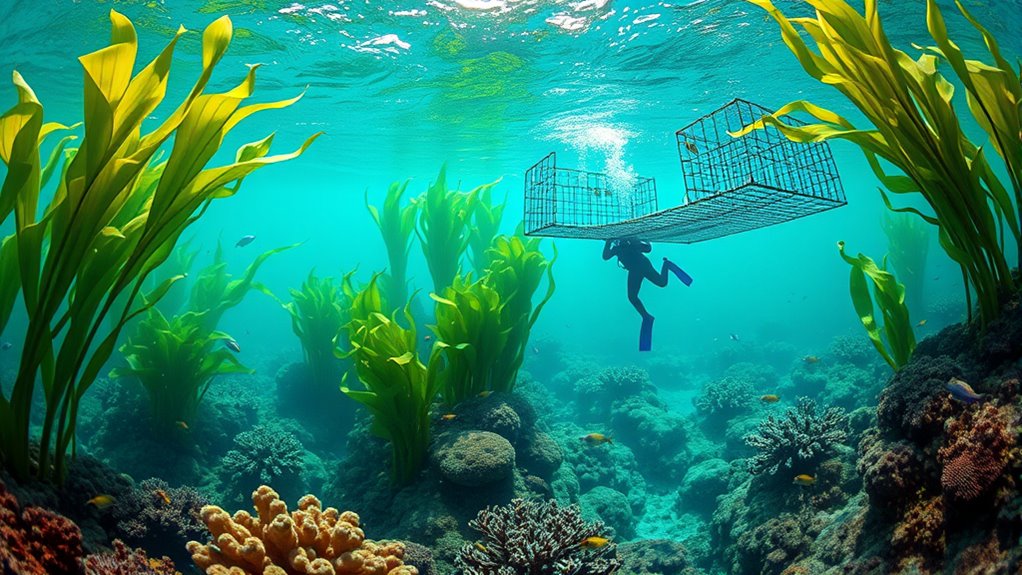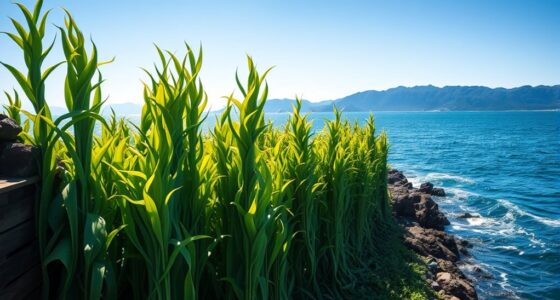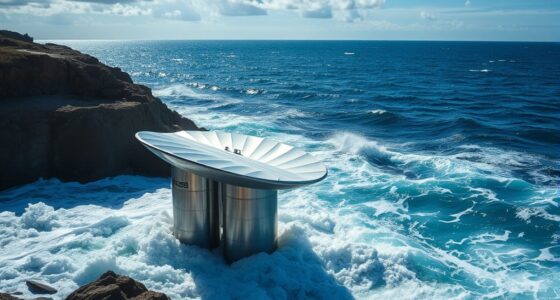Regenerative ocean farms help restore fish stocks and reefs by creating habitats that attract diverse species and provide safe breeding grounds. They rebuild damaged marine ecosystems through sustainable practices like cultivating resilient coral and supporting nutrient cycling. These farms reduce overfishing pressures and improve water quality, promoting biodiversity. If you want to discover how innovative technologies and ecosystem-based strategies are transforming ocean conservation, there’s much more to explore.
Key Takeaways
- Ocean farms create habitats that attract diverse fish species, supporting natural population growth and replenishment.
- They facilitate seafloor restoration and rebuild degraded habitats, enhancing biodiversity and water quality.
- Cultivating resilient coral and fish species helps restore reef structures and ecosystem complexity.
- Marine farms reduce overfishing pressures by serving as sustainable sources of seafood and breeding grounds.
- Innovative techniques like coral transplantation and habitat enhancement promote reef recovery and ecosystem stability.
The Decline of Marine Ecosystems and Its Causes

Marine ecosystems are experiencing a significant decline due to human activities and natural stressors. Pollution impacts, such as plastic waste, chemical runoff, and oil spills, damage habitats and threaten marine life. These pollutants can disrupt breeding, reduce food sources, and cause health issues for marine species. Overfishing consequences are equally damaging; excessive fishing depletes fish stocks faster than they can replenish, leading to imbalanced ecosystems. When key species are removed, it affects the entire food chain, causing further ecological instability. As a result, coral reefs weaken, fish populations decline, and biodiversity suffers. The combined effects of pollution impacts and overfishing consequences create a fragile marine environment that struggles to recover without intervention, emphasizing the urgent need for sustainable practices and innovative solutions. Urban pursuits and community engagement play a vital role in raising awareness and supporting conservation efforts for marine ecosystems.
Principles Behind Regenerative Ocean Farming

Regenerative ocean farming is built on principles that focus on restoring and enhancing marine ecosystems rather than exploiting them. Central to these principles is supporting marine nutrient cycling, which maintains ecosystem health by naturally recycling nutrients, reducing the need for artificial inputs. You’ll find that aquaculture integration is key, meaning different species work together to create balanced, resilient systems. For example, farmed shellfish filter water, improving water quality, while seaweeds absorb excess nutrients, preventing pollution. This synergy boosts fish stocks and reef health. Additionally, recognizing behaviors such as gaslighting can help in understanding how to protect and advocate for sustainable practices. Instead of depleting resources, regenerative farms mimic natural processes, fostering biodiversity and ecosystem stability. By prioritizing these core principles, you help rebuild marine environments, ensuring sustainable yields and healthier oceans for future generations.
Techniques and Technologies in Sustainable Marine Agriculture
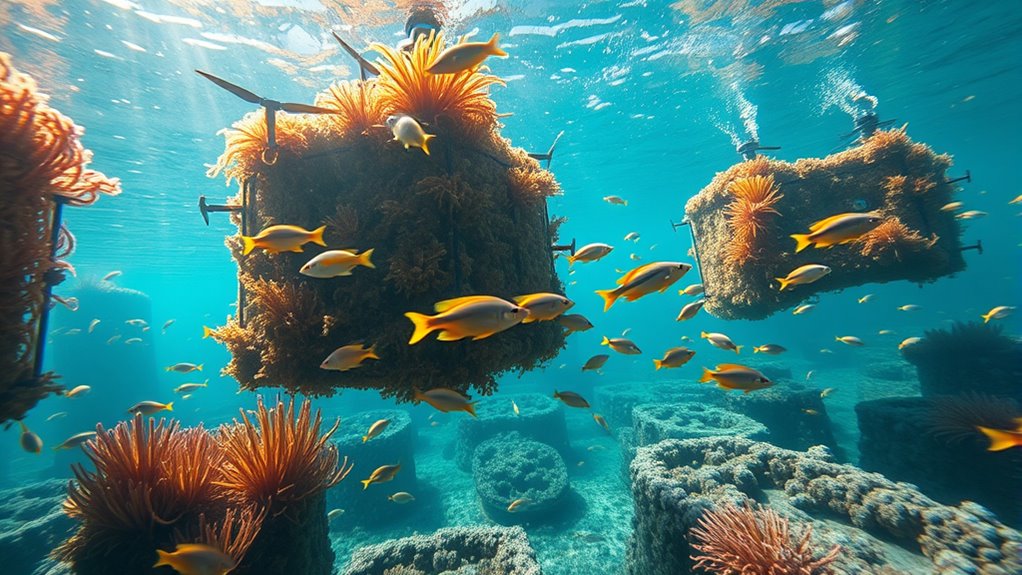
Advancements in techniques and technologies are transforming sustainable marine agriculture by making farms more efficient, resilient, and environmentally friendly. You now benefit from aquaculture innovations that optimize fish and shellfish growth while reducing environmental impacts. Marine plant cultivation has become more effective with new methods that enhance seaweed and seagrass production, supporting ecosystem health. These innovations include automated systems, selective breeding, and eco-friendly net designs. They help boost yields, improve resource use, and minimize waste. Here’s a quick overview of key techniques:
| Technique | Description | Benefit |
|---|---|---|
| Automated Monitoring | Sensors track conditions in real-time | Ensures optimal growth |
| Selective Breeding | Enhances species resilience and growth | Increases productivity |
| Eco-friendly Structures | Sustainable farm designs | Reduces ecological footprint |
How Ocean Farms Boost Fish Populations
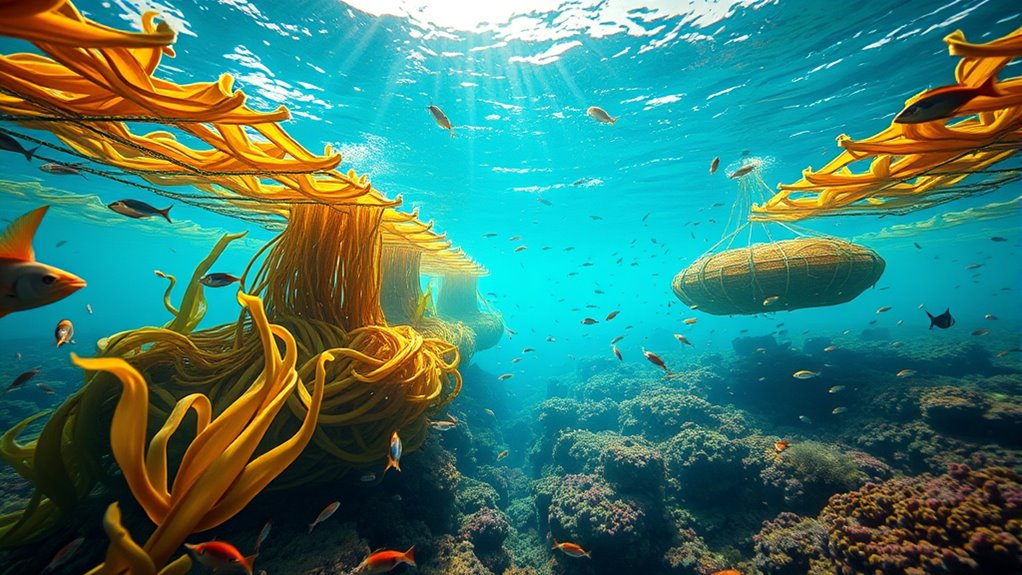
Ocean farms create thriving habitats that attract a variety of fish species. By enhancing natural environments and providing shelter, they support healthier and larger fish populations. This growth in biodiversity benefits the entire marine ecosystem and local fisheries. Additionally, innovative Kia Tuning techniques can optimize the performance of vessels involved in marine conservation efforts, improving efficiency and sustainability.
Enhancing Natural Habitats
When properly designed, ocean farms can substantially enhance natural habitats by providing safe breeding and nursery grounds for various fish species. Through seafloor restoration, they help rebuild degraded habitats, encouraging the return of native marine life. These farms create complex structures that serve as refuges, protecting juvenile fish from predators and offering ideal conditions for growth. Marine habitat enhancement occurs as the structures promote biodiversity, stabilize sediment, and improve water quality. As fish utilize these areas for spawning and nursery activities, populations naturally increase. Additionally, these farms can serve as fisheries management tools, helping regulate fish stocks and reduce overfishing pressures. Your efforts in designing sustainable ocean farms support the revival of healthy, resilient ecosystems, ultimately benefiting both marine life and local fishing communities. This approach transforms the ocean into a thriving, productive environment.
Promoting Biodiversity Growth
By providing structured habitats and shelter, ocean farms create ideal conditions for a diverse range of marine species to thrive. They act as biodiversity hotspots, attracting fish, invertebrates, and marine plants. This environment encourages marine plant restoration, which boosts food sources and shelter for smaller species. This process is crucial for supporting the economic growth factors of local communities through sustainable harvesting. As a result, fish populations grow naturally, supporting local ecosystems. The table below highlights how different species benefit from these farms:
| Species Type | Role in Biodiversity | Benefit from Ocean Farms |
|---|---|---|
| Fish | Predators & prey | Shelter and breeding sites |
| Invertebrates | Decomposers | Food source, habitat |
| Marine Plants | Primary producers | Food, oxygen production |
| Coral & Reefs | Habitat builders | Structural support |
| Microorganisms | Nutrient cycling | Enhanced microbial activity |
Restoring Coral Reefs Through Aquaculture Practices
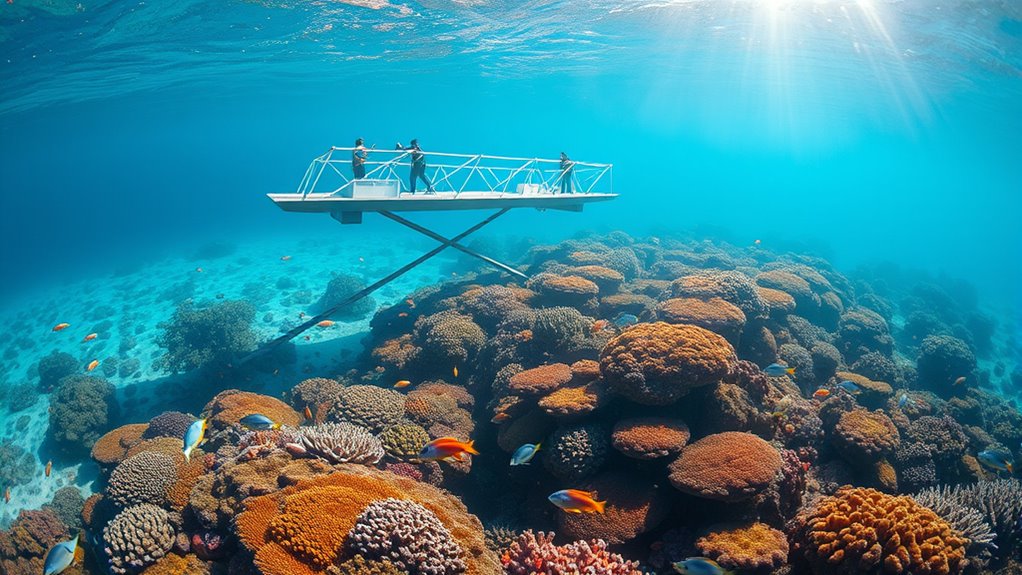
Restoring coral reefs through aquaculture practices offers a promising solution to combat the widespread decline of these essential ecosystems. You can participate in coral propagation efforts by cultivating healthy coral fragments in controlled environments, then transplanting them onto degraded reefs. This targeted approach accelerates reef rehabilitation, helping to rebuild the complex structures that support marine life. Aquaculture techniques allow you to grow resilient coral species that withstand environmental stressors, promoting long-term recovery. By actively engaging in these practices, you directly contribute to restoring biodiversity and reef health. These efforts not only revive the physical structure of coral reefs but also foster the re-establishment of vibrant, diverse ecosystems that benefit both marine life and local communities dependent on healthy oceans.
Benefits of Regenerative Ocean Practices for Local Communities

Regenerative ocean practices can boost your community’s food security by providing sustainable sources of seafood. They also create new job opportunities in aquaculture and related industries, strengthening the local economy. Plus, healthier ecosystems make your community more resilient to environmental changes and storms.
Enhanced Food Security
Regenerative ocean practices can considerably enhance food security for local communities by providing a stable and sustainable source of seafood and other marine resources. By investing in algae cultivation and marine biotechnology, you can diversify food sources and reduce reliance on overfished stocks. These practices support resilient ecosystems that produce abundant, nutritious seafood year-round. Additionally, they help protect traditional fisheries from collapse, ensuring long-term access to essential proteins. The benefits include:
- Increased availability of nutrient-rich algae for human consumption
- Reduced pressure on wild fish populations
- Improved resilience of local food systems
- Enhanced local economies through sustainable harvesting
- Greater food diversity supporting nutritional needs
Implementing regenerative ocean farming ensures communities have reliable access to crucial food sources, strengthening overall food security. This approach aligns with electric buses and VW ID. Buzz trends by promoting sustainable and innovative solutions for environmental challenges.
Job Creation Opportunities
As communities adopt ocean farming practices, they create numerous job opportunities that can boost local economies. Implementing aquaculture technology requires skilled workers to operate, maintain, and innovate systems that support sustainable fish and seaweed production. These jobs span from on-site farm management to research and development roles, offering livelihoods for a variety of skill levels. Additionally, marine policy plays a vital role in shaping regulations that encourage responsible growth, ensuring that new jobs align with environmental standards. This creates a stable foundation for local employment, attracting investments and fostering entrepreneurship. As a result, communities benefit from increased income, reduced unemployment, and a more resilient economy rooted in sustainable ocean practices. Moreover, understanding the costs of home security systems can help communities allocate resources effectively to support these initiatives.
Ecosystem Resilience
The growth of ocean farming not only creates jobs but also strengthens the health and stability of local ecosystems. Regenerative practices enhance ecosystem resilience by supporting diverse marine life and reducing vulnerability to climate impacts. When communities embrace marine policy that promotes sustainable methods, they help preserve reef structures and fish populations. Increased ocean literacy empowers you to understand these benefits and advocate for responsible practices. High refresh rates improve the overall performance of projectors used in marine research presentations.
- Boosts biodiversity, making ecosystems more adaptable
- Improves water quality through natural filtration
- Reduces the risk of coastal erosion
- Enhances habitat complexity for marine species
- Strengthens overall resilience against climate change
Challenges and Opportunities in Scaling Up Ocean Farming
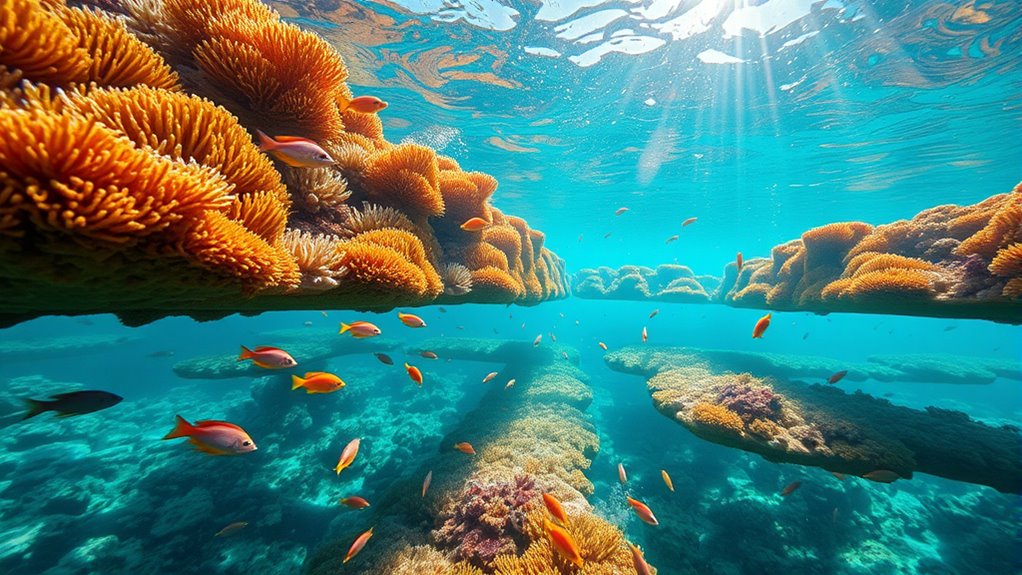
Scaling up ocean farming presents both significant opportunities and formidable challenges. To succeed, you need effective marine policy that balances environmental protection with economic growth. Clear regulations help prevent overexploitation and ensure sustainable practices. Funding strategies are essential; securing investments requires demonstrating long-term ecological and financial benefits. You must navigate complex permitting processes and address concerns from local communities and stakeholders. Infrastructure costs and technological innovations also pose hurdles, but advancements can boost efficiency and scalability. Collaboration across governments, scientists, and industry can accelerate growth and improve practices. While scaling up offers the chance to restore fish stocks and reefs, you must carefully manage risks and uncertainties. With strategic policies and funding, ocean farming can become a critical part of sustainable marine resource management. Incorporating balanced designs can further enhance the integration of eco-friendly practices into large-scale operations.
Future Perspectives for Marine Conservation and Fisheries Management
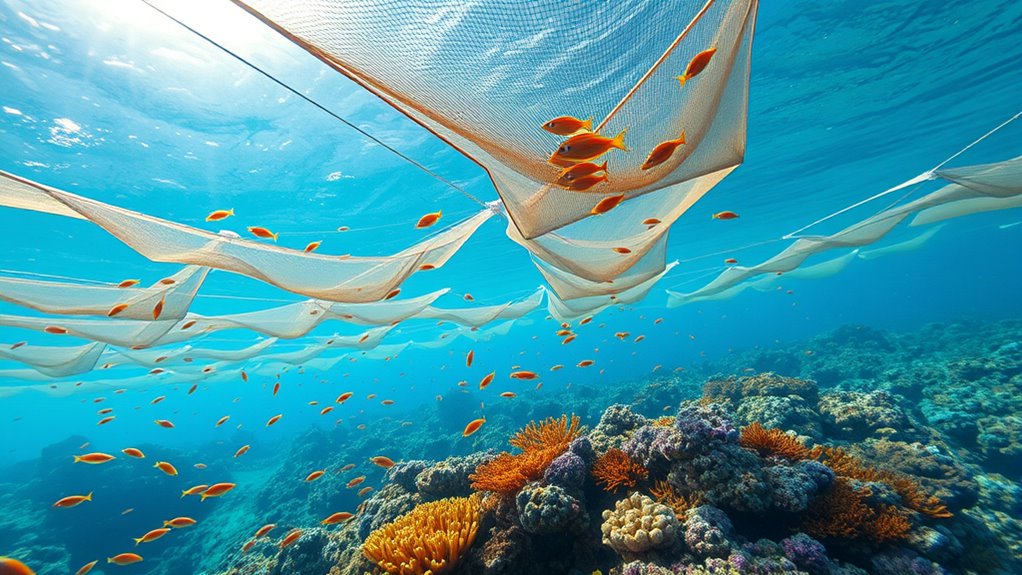
Looking ahead, innovative approaches and collaborative efforts will shape the future of marine conservation and fisheries management. You’ll see stronger marine policies that promote sustainable practices and protect biodiversity. Increasing public awareness is essential, as informed communities can support conservation initiatives and hold policymakers accountable. Emphasizing ecosystem-based management will guarantee healthier reefs and fish stocks. Technology, like remote sensing and data analytics, will enhance decision-making. Global cooperation will be indispensable to address transboundary issues. You should also expect a shift toward regenerative practices that restore ocean health rather than deplete resources. By combining science, policy, and public engagement, the future of marine conservation can become more resilient and effective. The success depends on your active participation and advocacy for sustainable ocean stewardship. Additionally, understanding risk assessment for merchant services can inform responsible resource management in marine industries.
Frequently Asked Questions
How Do Regenerative Ocean Farms Impact Local Biodiversity?
You’ll see that regenerative ocean farms boost local biodiversity by promoting coral enhancement and species diversification. These farms create habitats that attract various marine life, supporting healthier ecosystems. As you observe, they help restore the balance, encouraging different fish and coral species to thrive together. Your involvement in supporting such initiatives can lead to more resilient marine environments, ensuring a richer, more diverse underwater world for future generations.
What Are the Economic Incentives for Fishermen to Adopt Ocean Farming?
You’re likely wondering about the economic incentives for fishermen to adopt ocean farming. By embracing ocean farming, you gain better market access, allowing you to sell sustainably farmed products at higher prices. Additionally, subsidy programs can reduce initial costs and provide financial support, making it more attractive to shift from traditional fishing to farming. These incentives help you diversify income streams, improve sustainability, and contribute to healthier marine ecosystems.
Can Regenerative Practices Be Integrated With Existing Commercial Fisheries?
You can definitely have your cake and eat it too by integrating regenerative practices with existing fisheries. It’s like killing two birds with one stone. By adopting sustainable gear and engaging your community, you create a more resilient fishery. This approach not only helps restore fish stocks and reefs but also boosts long-term economic stability. Collaboration and innovation are key to making these practices work seamlessly alongside traditional fishing methods.
How Do Ocean Farms Mitigate the Effects of Climate Change on Marine Life?
You can help ocean farms combat climate change by supporting practices like using sustainable feed, which reduces pollution and greenhouse gases. These farms also promote carbon sequestration, absorbing CO2 from the atmosphere and storing it in marine ecosystems. By implementing such methods, ocean farms protect marine life from rising temperatures and acidification, ensuring healthier oceans and more resilient fish stocks for the future.
What Policies Support the Development of Regenerative Ocean Farming Initiatives?
Imagine a wave of policies transforming our oceans—it’s like ocean currents reshaping the future! You can support regenerative ocean farming by advocating for expanded marine protected areas, which shield ecosystems and boost fish stocks. Additionally, pushing for reforms in fishing subsidies guarantees sustainable practices. These policies encourage innovation, protect marine biodiversity, and create a resilient ocean economy, making your voice a powerful force in safeguarding our seas.
Conclusion
By embracing regenerative ocean farms, you help nurture the gentle rebirth of our seas, guiding marine life toward a brighter, more resilient future. These practices softly mend the delicate balance of reefs and fish stocks, offering hope where challenges once seemed overwhelming. Your support can become a quiet catalyst, fostering a thriving ocean domain where nature’s harmony gently reclaims its rightful place, ensuring vibrant waters for generations to come.

